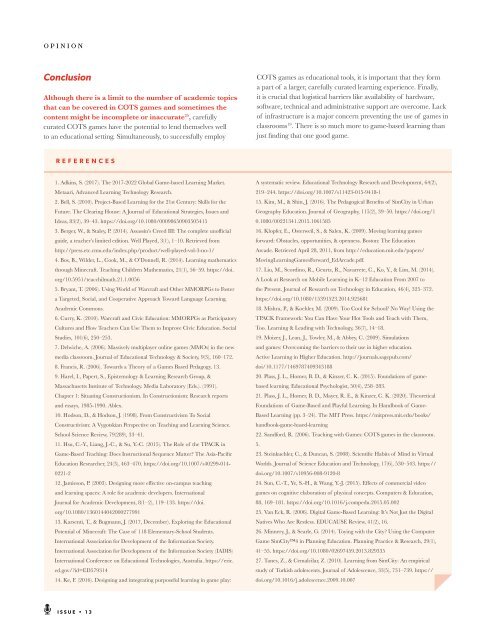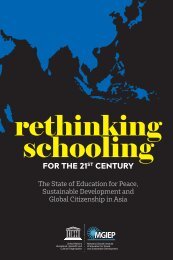The Blue DOT Issue 13
Reimagining Education: Beyond the Rhetoric
Reimagining Education: Beyond the Rhetoric
Create successful ePaper yourself
Turn your PDF publications into a flip-book with our unique Google optimized e-Paper software.
Conclusion<br />
Although there is a limit to the number of academic topics<br />
that can be covered in COTS games and sometimes the<br />
content might be incomplete or inaccurate 25 , carefully<br />
curated COTS games have the potential to lend themselves well<br />
to an educational setting. Simultaneously, to successfully employ<br />
REFERENCES<br />
COTS games as educational tools, it is important that they form<br />
a part of a larger, carefully curated learning experience. Finally,<br />
it is crucial that logistical barriers like availability of hardware,<br />
software, technical and administrative support are overcome. Lack<br />
of infrastructure is a major concern preventing the use of games in<br />
classrooms 19 . <strong>The</strong>re is so much more to game-based learning than<br />
just finding that one good game.<br />
AI In Early Childhood –<br />
Six Things Teachers<br />
Need to Know<br />
1. Adkins, S. (2017). <strong>The</strong> 2017-2022 Global Game-based Learning Market.<br />
A systematic review. Educational Technology Research and Development, 64(2),<br />
Metaari, Advanced Learning Technology Research.<br />
219–244. https://doi.org/10.1007/s11423-015-9418-1<br />
2. Bell, S. (2010). Project-Based Learning for the 21st Century: Skills for the<br />
15. Kim, M., & Shin, J. (2016). <strong>The</strong> Pedagogical Benefits of SimCity in Urban<br />
Future. <strong>The</strong> Clearing House: A Journal of Educational Strategies, <strong>Issue</strong>s and<br />
Geography Education. Journal of Geography, 115(2), 39–50. https://doi.org/1<br />
Ideas, 83(2), 39–43. https://doi.org/10.1080/00098650903505415<br />
0.1080/0022<strong>13</strong>41.2015.1061585<br />
3. Berger, W., & Staley, P. (2014). Assassin’s Creed III: <strong>The</strong> complete unofficial<br />
16. Klopfer, E., Osterweil, S., & Salen, K. (2009). Moving learning games<br />
guide, a teacher’s limited edition. Well Played, 3(1), 1–10. Retrieved from<br />
forward: Obstacles, opportunities, & openness. Boston: <strong>The</strong> Education<br />
http://press.etc.cmu.edu/index.php/product/well-played-vol-3-no-1/<br />
4. Bos, B., Wilder, L., Cook, M., & O’Donnell, R. (2014). Learning mathematics<br />
Arcade. Retrieved April 28, 2011, from http://education.mit.edu/papers/<br />
MovingLearningGamesForward_EdArcade.pdf.<br />
SAMIA KAZI<br />
through Minecraft. Teaching Children Mathematics, 21(1), 56–59. https://doi.<br />
17. Liu, M., Scordino, R., Geurtz, R., Navarrete, C., Ko, Y., & Lim, M. (2014).<br />
org/10.5951/teacchilmath.21.1.0056<br />
A Look at Research on Mobile Learning in K–12 Education From 2007 to<br />
5. Bryant, T. (2006). Using World of Warcraft and Other MMORPGs to Foster<br />
the Present. Journal of Research on Technology in Education, 46(4), 325–372.<br />
a Targeted, Social, and Cooperative Approach Toward Language Learning.<br />
https://doi.org/10.1080/15391523.2014.925681<br />
Academic Commons.<br />
18. Mishra, P., & Koehler, M. (2009). Too Cool for School? No Way! Using the<br />
6. Curry, K. (2010). Warcraft and Civic Education: MMORPGs as Participatory<br />
TPACK Framework: You Can Have Your Hot Tools and Teach with <strong>The</strong>m,<br />
Cultures and How Teachers Can Use <strong>The</strong>m to Improve Civic Education. Social<br />
Too. Learning & Leading with Technology, 36(7), 14–18.<br />
Studies, 101(6), 250–253.<br />
19. Moizer, J., Lean, J., Towler, M., & Abbey, C. (2009). Simulations<br />
7. Delwiche, A. (2006). Massively multiplayer online games (MMOs) in the new<br />
and games: Overcoming the barriers to their use in higher education.<br />
media classroom. Journal of Educational Technology & Society, 9(3), 160–172.<br />
Active Learning in Higher Education. http://journals.sagepub.com/<br />
8. Francis, R. (2006). Towards a <strong>The</strong>ory of a Games Based Pedagogy. <strong>13</strong>.<br />
9. Harel, I., Papert, S., Epistemology & Learning Research Group, &<br />
Massachusetts Institute of Technology. Media Laboratory (Eds.). (1991).<br />
Chapter 1: Situating Constructionism. In Constructionism: Research reports<br />
and essays, 1985-1990. Ablex.<br />
10. Hodson, D., & Hodson, J. (1998). From Constructivism To Social<br />
Constructivism: A Vygotskian Perspective on Teaching and Learning Science.<br />
School Science Review, 79(289), 33–41.<br />
11. Hsu, C.-Y., Liang, J.-C., & Su, Y.-C. (2015). <strong>The</strong> Role of the TPACK in<br />
Game-Based Teaching: Does Instructional Sequence Matter? <strong>The</strong> Asia-Pacific<br />
Education Researcher, 24(3), 463–470. https://doi.org/10.1007/s40299-014-<br />
0221-2<br />
12. Jamieson, P. (2003). Designing more effective on‐campus teaching<br />
and learning spaces: A role for academic developers. International<br />
Journal for Academic Development, 8(1–2), 119–<strong>13</strong>3. https://doi.<br />
org/10.1080/<strong>13</strong>60144042000277991<br />
<strong>13</strong>. Karsenti, T., & Bugmann, J. (2017, December). Exploring the Educational<br />
Potential of Minecraft: <strong>The</strong> Case of 118 Elementary-School Students.<br />
International Association for Development of the Information Society.<br />
International Association for Development of the Information Society (IADIS)<br />
International Conference on Educational Technologies, Australia. https://eric.<br />
ed.gov/?id=ED579314<br />
14. Ke, F. (2016). Designing and integrating purposeful learning in game play:<br />
doi/10.1177/1469787409343188<br />
20. Plass, J. L., Homer, B. D., & Kinzer, C. K. (2015). Foundations of gamebased<br />
learning. Educational Psychologist, 50(4), 258–283.<br />
21. Plass, J. L., Homer, B. D., Mayer, R. E., & Kinzer, C. K. (2020). <strong>The</strong>oretical<br />
Foundations of Game-Based and Playful Learning. In Handbook of Game-<br />
Based Learning (pp. 3–24). <strong>The</strong> MIT Press. https://mitpress.mit.edu/books/<br />
handbook-game-based-learning<br />
22. Sandford, R. (2006). Teaching with Games: COTS games in the classroom.<br />
5.<br />
23. Steinkuehler, C., & Duncan, S. (2008). Scientific Habits of Mind in Virtual<br />
Worlds. Journal of Science Education and Technology, 17(6), 530–543. https://<br />
doi.org/10.1007/s10956-008-9120-8<br />
24. Sun, C.-T., Ye, S.-H., & Wang, Y.-J. (2015). Effects of commercial video<br />
games on cognitive elaboration of physical concepts. Computers & Education,<br />
88, 169–181. https://doi.org/10.1016/j.compedu.2015.05.002<br />
25. Van Eck, R. (2006). Digital Game-Based Learning: It’s Not Just the Digital<br />
Natives Who Are Restless. EDUCAUSE Review, 41(2), 16.<br />
26. Minnery, J., & Searle, G. (2014). Toying with the City? Using the Computer<br />
Game SimCity4 in Planning Education. Planning Practice & Research, 29(1),<br />
41–55. https://doi.org/10.1080/02697459.20<strong>13</strong>.829335<br />
27. Tanes, Z., & Cemalcilar, Z. (2010). Learning from SimCity: An empirical<br />
study of Turkish adolescents. Journal of Adolescence, 33(5), 731–739. https://<br />
doi.org/10.1016/j.adolescence.2009.10.007<br />
Samia Kazi, Regional Director for the<br />
Middle East for CE International, is a<br />
social entrepreneur, innovator, and<br />
partnership builder. She worked as a<br />
CEO of a leading ECE organization in<br />
the Middle East, called Arabian Child,<br />
supporting quality improvement,<br />
child protection, and early childhood<br />
education. <strong>The</strong> Huffington Post<br />
named her one of the top women<br />
who are reshaping early childhood<br />
education in the Middle East. Samia<br />
has a bachelors degree in applied<br />
computing, as well as a masters and<br />
a doctorate degree in early childhood<br />
education policy and education<br />
leadership. Samia strives to balance<br />
her love of technology and innovation,<br />
with her passion for early childhood<br />
education and care. She is especially<br />
interested in multi-sectoral, systembased<br />
planning for quality assurance<br />
in the early years.<br />
W<br />
hether we like it or<br />
not, artificial intelligence<br />
is almost certainly an<br />
inevitability in the<br />
future of education. Attempts to design<br />
artificially intelligent curriculums for<br />
early childhood already exist, such as the<br />
MIT-developed “PopBots,” meant to help<br />
preschool children interact with social<br />
robots to learn AI concepts. However,<br />
as research into AI and its application to<br />
the education sector expands, we need to<br />
consider the readiness of current teachers,<br />
and prepare future teachers, for this new<br />
reality.<br />
In the recent past, AI in education may<br />
have seemed like a daunting, albeit distant,<br />
possibility, but turbulent times have<br />
catapulted us into the future. <strong>The</strong> time<br />
to prepare our teachers to understand,<br />
monitor, analyze, and select appropriate<br />
AI applications to use in early childhood<br />
education is NOW.<br />
Teaching young children about what<br />
computers or social robots can do is not<br />
enough. Teachers will also need to guide<br />
children in their understanding about<br />
what these machines cannot do. For<br />
example, machines are not humans<br />
and they are not good at ethical<br />
decision making, making moral<br />
choices, or applying social-emotional<br />
intelligence. <strong>The</strong>se are skills teachers<br />
must nurture in children as they will<br />
be especially important as children<br />
begin to interface more with AI.<br />
ISSUE • <strong>13</strong><br />
1 5

















